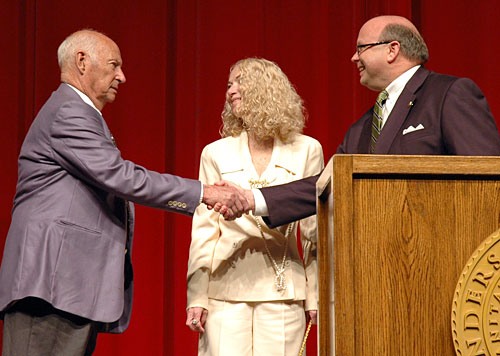Before an audience of students, faculty and staff gathered in Henderson Auditorium, Anderson University announced today during its weekly campus worship service that it has received the largest gift of property for campus use in its 97-year history.
 Anderson University president Evans Whitaker, right, expresses appreciation to John and Marie Pracht of Anderson for their gift of 125 acres of property near the school’s campus. Part of the land could become a wetlands biology observatory.
Anderson University president Evans Whitaker, right, expresses appreciation to John and Marie Pracht of Anderson for their gift of 125 acres of property near the school’s campus. Part of the land could become a wetlands biology observatory.The gift of approximately 125 acres bordering the Rocky River was given by longtime friends and supporters of the university, John and Marie Pracht, of Anderson. The gift brings the school’s campus acreage to just short of 200 acres.
In making the announcement, university president Evans P. Whitaker said, “We are absolutely thrilled with Mr. and Mrs. Pracht’s gift of this strategic property. It is, quite literally, the most important gift of real estate contiguous to the campus since the founders gave the original 30 acres for a campus in 1910.”
The property holds potential for the development of unique amenities that the university ultimately wants to make available to its students and share with the community. Plans for the property are not solidified, but the school will engage professional counsel to help determine the best use for the property and develop a long range vision.
Pracht and Whitaker, along with the school’s vice president for institutional advancement, Dean Woods, have been talking about the intended gift for several years.
“Shortly after Mr. Pracht made the commitment to give the property, he put me in his pickup truck and took me over the acreage,” Whitaker said. “It was soon evident that John loves this special property, and he wanted to share it with others. We’re simply overwhelmed by John and Marie’s thoughtfulness and generosity.”
Pracht is an attorney and entrepreneur. He and his wife have lived near the campus for many years and have developed a deep appreciation of and affection for the university. “This is a wonderful gift that demonstrates Mr. and Mrs. Pracht’s commitment to Christian higher education and Anderson University,” Woods said. “We intend to be good stewards of the Prachts’ generosity and foresight.”
The Pracht property includes approximately 40 acres of pristine wetlands, something that is relatively rare in the Upstate region of South Carolina. Whitaker says he can envision developing the area into “something of a preserve with walking trails and boardwalks where students of all ages can enjoy and study the curiosities of the wetlands and the beauty of God’s creation.” Long-range, the school may also consider the construction of an observatory on the adjacent uplands and possibly use part of the property for athletic, equestrian, and/or student life purposes.
Tom Kozel, chair of the department of natural sciences, says the property represents a “wonderful opportunity” for students and faculty in Anderson University’s biology program. “Both uplands and wetlands ecosystems can be used immediately as part of various field exercises in ecology, invertebrate biology and field biology classes,” Kozel said.
The university is open to forming community partnerships to cultivate the sites in an ecologically friendly manner and encourage use by other universities and local school and nature groups. Whitaker said he hopes local governments will consider partnering with the university to preserve the school’s wetlands and adjacent wetlands in the area for the enjoyment of residents and visitors.